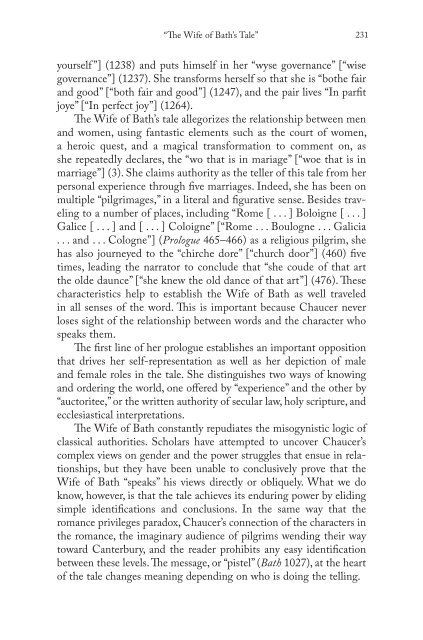Blooms Literary Themes - THE TRICKSTER.pdf - ymerleksi - home
Blooms Literary Themes - THE TRICKSTER.pdf - ymerleksi - home
Blooms Literary Themes - THE TRICKSTER.pdf - ymerleksi - home
You also want an ePaper? Increase the reach of your titles
YUMPU automatically turns print PDFs into web optimized ePapers that Google loves.
“Th e Wife of Bath’s Tale” 231<br />
yourself ”] (1238) and puts himself in her “wyse governance” [“wise<br />
governance”] (1237). She transforms herself so that she is “bothe fair<br />
and good” [“both fair and good”] (1247), and the pair lives “In parfi t<br />
joye” [“In perfect joy”] (1264).<br />
Th e Wife of Bath’s tale allegorizes the relationship between men<br />
and women, using fantastic elements such as the court of women,<br />
a heroic quest, and a magical transformation to comment on, as<br />
she repeatedly declares, the “wo that is in mariage” [“woe that is in<br />
marriage”] (3). She claims authority as the teller of this tale from her<br />
personal experience through fi ve marriages. Indeed, she has been on<br />
multiple “pilgrimages,” in a literal and fi gurative sense. Besides traveling<br />
to a number of places, including “Rome [ . . . ] Boloigne [ . . . ]<br />
Galice [ . . . ] and [ . . . ] Coloigne” [“Rome . . . Boulogne . . . Galicia<br />
. . . and . . . Cologne”] (Prologue 465–466) as a religious pilgrim, she<br />
has also journeyed to the “chirche dore” [“church door”] (460) fi ve<br />
times, leading the narrator to conclude that “she coude of that art<br />
the olde daunce” [“she knew the old dance of that art”] (476). Th ese<br />
characteristics help to establish the Wife of Bath as well traveled<br />
in all senses of the word. Th is is important because Chaucer never<br />
loses sight of the relationship between words and the character who<br />
speaks them.<br />
Th e fi rst line of her prologue establishes an important opposition<br />
that drives her self-representation as well as her depiction of male<br />
and female roles in the tale. She distinguishes two ways of knowing<br />
and ordering the world, one off ered by “experience” and the other by<br />
“auctoritee,” or the written authority of secular law, holy scripture, and<br />
ecclesiastical interpretations.<br />
Th e Wife of Bath constantly repudiates the misogynistic logic of<br />
classical authorities. Scholars have attempted to uncover Chaucer’s<br />
complex views on gender and the power struggles that ensue in relationships,<br />
but they have been unable to conclusively prove that the<br />
Wife of Bath “speaks” his views directly or obliquely. What we do<br />
know, however, is that the tale achieves its enduring power by eliding<br />
simple identifi cations and conclusions. In the same way that the<br />
romance privileges paradox, Chaucer’s connection of the characters in<br />
the romance, the imaginary audience of pilgrims wending their way<br />
toward Canterbury, and the reader prohibits any easy identifi cation<br />
between these levels. Th e message, or “pistel” (Bath 1027), at the heart<br />
of the tale changes meaning depending on who is doing the telling.

















